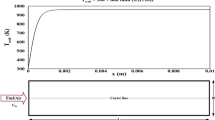Abstract
Lean premixed combustion is a well known method in gas turbine combustors that can reduce fuel consumption and decrease flame temperature. In lean premixed flames, flame instabilities can occur because the combustion takes place near the lean flammable limit. For the purpose of increasing flame stability, a small amount of hydrogen was added into a fuel, which has ultra low lean flammable limit. The extinction stretch rate increased and total equivalence ratio at extinction decreased with hydrogen addition; consequently, ultra lean premixed combustion was possible and flame stability could be achieved at low temperature conditions. The NOx emission increased with hydrogen addition for the same stretch rate and equivalence ratio, but the extinction stretch rate and lean flammability limit was enlarged. Consequently, NOx emission decreased with hydrogen addition in the near extinction conditions. Hydrogen addition could improve flame stability and reduce NOx emission in ultra lean premixed combustion.
Similar content being viewed by others
References
K. Y. Ahn et al., An Experimental Study on Combustion Processes and NOx Emission Characteristics of the Air-Staged Burner, KSME Int. J. 13 (1999) 477–486.
E.-S. Cho, Y. Sung and S. H. Chung, An Experiment on Low NOx Combustion Characteristics in a Multi-Staged Burner, Transaction of KSME (B) 27 (2003) 32–38.
E.-S. Cho and S. H. Chung, Characteristics of NOx Emission with Flue Gas Dilution in Air and Fuel Sides, KSME Int’l J. 18 (2004) 2303–2309.
E.-S. Cho and S. H. Chung, Numerical Study on NO Emission with Flue Gas Dilution in Air and Fuel Sides, J. of Mech. Sci. Technol. (KSME Int’l J.) 19 (2005) 1393–1400.
A. H. Lefebvre, Gas Turbine Combustion, Taylor & Francis, (1983).
C. T. Bowman, Control of Combustion Generated Nitrogen Oxide Emissions: Technology Driven by Regulation, Proc. Combust. Instit. 24 (1992) 859–878.
B. S. Brewster et al., Modeling of Lean Premixed Combustion in Stationary Gas Turbines, Prog. Energy Combust. Sci. 25 (1999) 353–385.
S. M. Correa, A Review of NOx Formation under Gas-Turbine Combustion Conditions, Combust Sci. Technol. 87 (1993) 329–362.
R. E. Jones, Gas Turbine Engine Emissions- Problems, Progress and Future, Prog. Energy Combust. Sci. 4 (1978) 73–1.
Y. Sakai and M. Kurimoto, A Improvement of Lean Combustion Characteristics with Hydrogen Addition in a Flat Stretched Flame, Transactions of JSME (B) 67 (2001) 529–535.
G. S. Jackson et al., Influence of H2 on the Response of Lean Premixed CH4 Flames to High Strained Flows, Combust. Flame 132 (2003) 503–511.
A. E. Lutz et al., OPPDIF: A FORTRAN Program for Computing Opposed-Flow Diffusion Flames, Sandia National Laboratories Report, SAND96-8243 (1997).
R. J. Kee et al., CHEMKIN-III: A FORTRAN Chemical Kinetics Package for the Analysis of Gas-Phase Chemical and Plasma Kinetics. Sandia National Laboratories Report, SAND 96-8216 (1996).
G. P. Smith et al., Gri-Mech 3.0. http://www.me.berkeley.edu/gri_mech/ (2000).
G. Yu, C. K. Law and C. K. Wu, Laminar Flame Speeds of Hydrocarbon + Air Mixtures with Hydrogen Addition, Combust. Flame 63 (1986) 339–347.
R. J. Kee et al., A FORTRAN Program for Modeling Steady Laminar One-Dimensional Premixed Flames, Sandia National Laboratories Report, SAND 85-8240 (1985).
E.-S. Cho, T. K. Oh and S. H. Chung, Local Karlovitz Numbers at Extinction for Various Fuels in Counterflow Premixed Flames, Combust Sci. Technol. 178(9) (2006) 1559–1584.
C.-J. Tseng, Effects of Hydrogen Addition on Methane Combustion in a Porous Medium Burner, Int. J. Hydrogen Energy 27 (2002) 699–707.
T. Takeno and M. Nishioka, Species Conservation and Emission Indices for Flame Described by Similarity Solutions, Combust. Flame 92 (1993) 465–448.
M. Nishioka et al., NO Emission Characteristics of Methane-Air Double Flame, Combust. Flame 98 (1994) 127–138.
Author information
Authors and Affiliations
Corresponding author
Additional information
This paper was recommended for publication in revised form by Associate Editor Ohchae Kwon
Dr. Eun-Seong Cho received his B.S. and M.S. degrees in Mechanical Engineering from Hanyang University, Korea, in 1996 and 1998, respectively. He then received his Ph.D. degree from Seoul National University, Korea, in 2005. He was a principal engineer of KD Navien research center and currently a research associate at Delft University of Technology, The Netherlands. His research interests include eco-friendly clean combustion technology, new and renewable energy systems.
Prof. Suk Ho Chung received his B.S. degree from Seoul National University, Korea, in 1976 and Ph.D. degree in Mechanical Engineering from Northwestern University, USA, in 1983. He is a Professor since 1984 in the School of Mechanical and Aerospace Engineering at Seoul National University in Seoul, Korea. His research interests cover combustion fundamentals, pollutant formation, laser diagnostics, and plasma-assisted combustion.
Rights and permissions
About this article
Cite this article
Cho, ES., Chung, S.H. Improvement of flame stability and NOx reduction in hydrogen-added ultra lean premixed combustion. J Mech Sci Technol 23, 650–658 (2009). https://doi.org/10.1007/s12206-008-1223-x
Received:
Revised:
Accepted:
Published:
Issue Date:
DOI: https://doi.org/10.1007/s12206-008-1223-x




